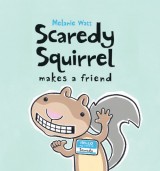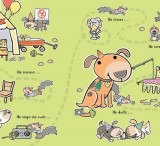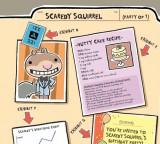The outside world is full of germs, sharks and killer bees, at least according to the comically paranoid Scaredy Squirrel...
If I tell you this book is about a character who is completely paranoid, slightly OCD and plagued with serious agoraphobic tendencies, you might think it’s not the ideal choice to inspire your KS1 pupils. But that’s not the whole story.
 Here we have an epic character who, against all odds, overcomes the terror of life in a nut tree and bravely faces fears that one can only imagine. And, of course, they are only imagined!Let me introduce you to the one, the only, Scaredy Squirrel.
Here we have an epic character who, against all odds, overcomes the terror of life in a nut tree and bravely faces fears that one can only imagine. And, of course, they are only imagined!Let me introduce you to the one, the only, Scaredy Squirrel.
This hilarious book by Melanie Watt was introduced to me by a colleague, as so often is the case. We laughed so much and since then the nutty yet adorable squirrel has been a firm favourite to share with children who seem to completely understand his obsessive, over cautious behaviour and, of course, who - as indeed we all do - have fears of their own. Scaredy tells us, in his own words, what the book is about:
Here’s the story, in a nutshell:
I never leave my nut tree.
It’s way too dangerous out there.
I could encounter germs, poison
ivy or sharks.
If danger comes along, I’m
prepared. I have antibacterial
soap, sticking plaster and
a parachute.
But things really get shaken up
later in the book when I’m
forced out of my tree by a
vicious intruder!
Will I survive this ordeal?
Will I undergo a life changing
experience?
Will I discover my true
inner self?
How can you resist such a tale?
 At the beginning of the book we are introduced to Scaredy’s world (although, even before the first page turns, he is insistent that everyone wash their hands with antibacterial soap before touching a page further). His surroundings seem normal enough: simple nut trees, bushes, a meadow and river. However, we find out that everything outside his own nut tree is, in fact, ‘the unknown’ - a place where untold terrors lurk.
At the beginning of the book we are introduced to Scaredy’s world (although, even before the first page turns, he is insistent that everyone wash their hands with antibacterial soap before touching a page further). His surroundings seem normal enough: simple nut trees, bushes, a meadow and river. However, we find out that everything outside his own nut tree is, in fact, ‘the unknown’ - a place where untold terrors lurk.
Scaredy lists just a few of his many fears: tarantulas, poison ivy, green Martians, killer bees, sharks and, of course, germs. The book provides a wonderful opportunity to discuss with children the entirely human emotion of fear. They see that, like Scaredy, we all have lots of fears: some real and some imagined, but nevertheless still real to us.
• With the class, explore what happens when we face our fears or, like Scaredy, face them by accident.
• Get the children to create a story map of ‘the unknown’ and then ask them to take each of Scaredy’s fears and plot where on the map they think they might belong. Can they label the danger zones?
• Ask the children to discuss which of the fears they think are real and which imagined. How do they think they could reassure Scaredy not to be afraid of green Martians, for instance?
• Talk with children about what they are afraid of. Get them to make lists, just like Scaredy, to share with each other. Do they also have fears that may not be rational? Of course, we all do, which is really good for them to know.
• Another superb book to help explore this theme alongside Scaredy Squirrel is the amazing Little Mouse’s Big Book of Fears by Emily Gravett (Macmillan Children’s Books). Like the mouse in the book, the children could take their list of fears and make a collage of them from newspapers and magazines - Little Mouse finds this is a great way to face his fears. Perhaps you could then make a collage of all their favourite things, some real and some imagined.
• This lovely introduction video to the Little Mouse book is super to share with children to help them start thinking about their own fears (youtube/P4ey-MVevq4).
 Scaredy Squirrel is very practical and thinks carefully about how to cope with his fears. Before he finalises his strategy he does question whether it may be worth facing his fears and decides to draw up another list - advantages and disadvantages of never leaving the nut tree.
Scaredy Squirrel is very practical and thinks carefully about how to cope with his fears. Before he finalises his strategy he does question whether it may be worth facing his fears and decides to draw up another list - advantages and disadvantages of never leaving the nut tree.
Share Scaredy’s advantages list with the children; great view, plenty of nuts, safe place, no tarantulas, poison ivy, green Martians, killer bees, germs or sharks. Can they come up with the disadvantages of never leaving home? Scaredy does come up with a few but considers them not worth the risk. Do the children think he is right? Now he needs a plan.
• Scaredy Squirrel comes up with two solutions. Firstly, to avoid his fears at all costs and then secondly, to keep everything ‘under control.’ Scaredy applies himself to the task hilariously. He has a clear action plan; a strict routine, an emergency kit and a top secret exit strategy.
• Scaredy has a weekly plan of activities and a strict daily timetable solely involving lots of looking at the view and eating nuts. Set children the task of making their own timetables: one for the week and one for a day. Perhaps they can compare home and school days. Opportunities for exploring time and labelling clock times on their timetables, along with the use of imperative verbs that Scaredy uses in his daily routines - wake up, a nut, look at view - can be integrated into the activities.
• Explore some playful writing. This time, can children create a dream timetable of imagined activities? What would they like to be doing on their perfect day? For example:
My perfect day
1. Be woken up by a rainbow pouring into my bedroom.
2. The sun knocks on my window and waves.
3. The three bears bring me breakfast in bed (chocolate cake, of course!).
4. My genie gives me my three wishes for the day.
Give children a few ideas to get them started, create a storm of ideas together and then write a simple list poem as a class. The children can go on to write their own perfect day poems.
 Scaredy compiles his very own emergency kit of essential items just in case something unexpected does actually happen.
Scaredy compiles his very own emergency kit of essential items just in case something unexpected does actually happen.
• Make up your own kit of Scaredy’s items to bring and show the children: bug spray, rubber loves, sticking plaster, calamine lotion and sardines to name a few. Put the items in the centre of a circle and ask for volunteers. Can the children match an items to one of his fears and explain how Scaredy might use them? We do eventually find out what the sardines are for, but what ideas have the children got!?
Superb opportunities for some drama and role-play arise as he comes up with a six point plan of immediate action.
1. Panic
2. Run
3. Get kit
4. Put on kit
5. Consult exit plan
6. Exit tree
7. A life changing experience
The Mission Impossible theme music is great for this activitiy. As soon as the children hear the music, they begin at step 1. Each time the music stops they have to freeze, when it starts again they move on to the next step to act out. Super fun.
When disaster does come into Scaredy Squirrel’s carefully planned existence, things don’t go quite to plan. However, in the process he has an amazing moment of self discovery in mid air as he realises that a parachute was not needed. He is, in actual fact, a flying squirrel! In flying he finds moments of freedom from all his fears. He feels overjoyed, adventurous, carefree and alive.
• Explore with children the language used to show his new, never experienced feelings. Brainstorm and collect synonyms of these new feelings and then get the children to think about how he must have been feeling before when he was full of fear. For each new feeling, can the children find a contrasting antonym: adventurous / cowardly; overjoyed / miserable, etc.? Choosing their favourite words and acting one out really brings them alive.
 At this point the children will be curious about whether squirrels can actually fly, which provides a lovely jumping off point for research into real squirrels and how they live. You may want to collect information in a class fact file or even write some simple non-chronological reports. As a fun model, you could write your own report about the species known as scaredy squirrels: where they can be found (definitely not in ‘the unknown’); their characteristics - highly organised, suspicious, often fearful; some of their habits - a compulsion to make lists, frequent use of binoculars, etc. Again, the children can use your model and structure to write their own reports on real squirrels or, if you have younger children, scribe a class shared report.
At this point the children will be curious about whether squirrels can actually fly, which provides a lovely jumping off point for research into real squirrels and how they live. You may want to collect information in a class fact file or even write some simple non-chronological reports. As a fun model, you could write your own report about the species known as scaredy squirrels: where they can be found (definitely not in ‘the unknown’); their characteristics - highly organised, suspicious, often fearful; some of their habits - a compulsion to make lists, frequent use of binoculars, etc. Again, the children can use your model and structure to write their own reports on real squirrels or, if you have younger children, scribe a class shared report.
The differences between Scaredy Squirrel and his real life counterparts will begin to be apparent. The old BBC programme Clever Critters is still available on Youtube (youtube/TamMqvk4Bb8) and you can find some excellent footage of squirrels doing amazing clever and adventurous things, of course very unlike our epic hero.
Another superb book to read and explore with children is the fantastic Those Darn Squirrels! by Adam Rubin, illustrated by Daniel Salmieri. In this wonderful story the squirrels wage war against Old Man Fookwire, a bird lover who likes to put nuts and seeds out for them regularly. Unfortunately, he is plagued by the daring antics of a family of squirrels who live in his garden and devise raids to thwart his best efforts to feed the birds.
Scaredy does change by accidentally facing his fears, although, as you will see, ‘playing dead’ is still an integral part of his new regime - just in case. He then, in subsequent adventures, faces more fears and creates more outrageous action plans. Look out for Scaredy Squirrel Makes a Friend, Scaredy Squirrel at Night, Scaredy Squirrel at the Beach, and the very funny Scared Squirrel Has a Birthday Party. Finally, challenge your class to write Scaredy’s next adventure: will he start school? Visit the shops? Learn to swim? Go nuts!
Judy Clark is Leaders Network Manager at the National Literacy Trust (literacytrust.org.uk). She has worked alongside Pie Corbett to develop Talk for Writing in practice and deliver training to schools.
Supporting parents with maths
Ace-Maths
Join the tribe with a stone age forest school
Ace-Classroom-Support
